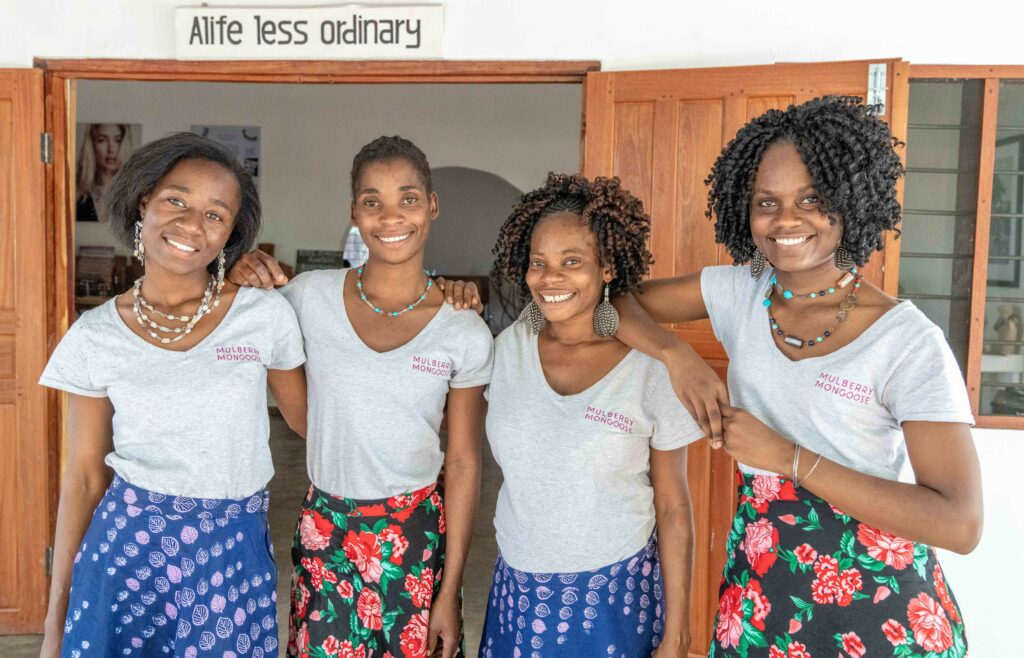
Phelida, Clera, Grace and Peggy at the Mulberry Mongoose workshop.
Mulberry Mongoose, a Mfuwe project that turns brutal snare wire into beautiful jewellery for men and women, has been nominated for an Earthshot Prize in the Protect and Restore Nature Category. Prince William founded the prize in 2021 as a way of finding practical solutions to pollution, biodiversity loss, climate change and other challenges we have created for ourselves and the planet. The nominee is Sekayi Fundafunda, who has long followed Mulberry Mongoose’s work and who helps African fashion companies develop sustainable practices and new narratives via her company based in Lusaka.
Mulberry Mongoose has raised around USD140 000 and counting for conservation.
Earthshot has 370 official nominators in almost 70 countries who carefully consider which projects are making enough of an impact to be rewarded with a million-pound prize. If Mulberry Mongoose is a finalist, they will join the illustrious African ranks of Reeddi Capsules in Nigeria (2021 finalist in the Fix Our Climate category), Sanergy from Kenya (2021 finalist in Build A Waste-free Future) and Roam from Kenya (2022 finalist in Clean Our Air). If they triumph, they will be the second African winner after Mukuru Clean Stoves from Kenya in the Clean Our Air section for 2022.
A win will be a huge boost for Zambia so everyone hold thumbs!
Sourcing the wire
The team at Mulberry Mongoose sources the snare wire from Conservation South Luangwa, the Department of National Parks and Wildlife (from around Lusaka) and African Parks up in Kafue National Park. Instead of this waste material being stored and possibly stolen to be reused, the artists at Mulberry Mongoose painstakingly transform it into an income-generating symbol of the power of good.

Sorting out confiscated snare wire.
Finding inspiration everywhere
New designs are released twice a year while classic pieces may also get refreshed and improved. Founder Kate Wilson explains the process:
‘We look to launch new designs twice a year. We are also always tracking and improving our existing designs. Typically we set aside two weeks to focus on design work. I will lay out all the materials we want to use across our design desks. We will create the snare beads we want to use and experiment to get the right shape. Then we work on multiple ideas at once.
‘The starting idea will be the inspiration: perhaps the shape of a leaf, the movement of an animal or even a necklace seen on a local lady doing her shopping. There is always a visual trigger. Then we work hard to incorporate the meaningful local materials – like feathers or leather – into the design to maximise how it represents our unique location and invests back into the economy.
‘Working out how to manipulate the snare wire to create the shape we envisioned is by far the hardest part. I tend to lay everything out and then ask the team members to create it, then we rework it until the look is just right. I always feel a kick in my tummy when the design works and the beautiful part is the team is always on the same page. We always know when we have it and we always agree. Until we have that feeling, we keep experimenting. If we work on 10 designs at once we probably select four or five of them that work. The rest we put away and revisit later.
‘For those four of five selected designs we then test them for durability and that takes four months of a team member wearing them constantly. Once they pass we then sell in our shop to make sure our clients enjoy them and they will be successful. Only then do they make our catalogue and become part of our core collection.’
Pieces for pangolins
Pangolins are the most widely trafficked animals in the world. Kate explains why Mulberry Mongoose introduced a design based on its iconic scales, which can protect it from lions but not people…
‘This design is very close to my heart both due to its purpose and because it exemplifies the workmanship and dedication of my wonderful team. We designed it after seeing ‘Eye of the Pangolin’ by Bruce Young and Johan Vermeulen. It really wasn’t an easy creation. It took many attempts to create jewellery entirely from snare wire (apart from the rivets) that connected to the unique quality of the pangolin.
‘Each individual piece takes an average of two hours to create by hand (the bracelet taking nearly three hours) and is so physical that we work to a “one day on, one day off rule” when making it. Every sale benefits both anti-snare patrols and the Pangolin Crisis Fund. Wearing it connects you with very special like-minded souls and our workshop and team in the South Luangwa.’
MM on famous faces
Mulberry Mongoose’s rustic-chic designs are worn by innumerable ‘ordinary’ people who bought a piece from the shop in Mfuwe (although there’s nothing ‘ordinary’ about folks who support conservation work) and also heaps of more well-known faces.
These include Dutch supermodel Doetzen Kroes who is also patron of the HIV/Aids charity, Dance4Life; Bollywood actress Natasha Mago who was in Eat, Pray, Love; Aussie media personality Jessica Ridley and American travel and sustainable-living blogger, Michaela Guzy.
British author, documentary filmmaker, Malaria Awareness Campaign representative and member of the Council of Ambassadors for the World Wildlife Fund, Simon Reeve, wears pieces as does explorer, chairwoman of How Many Elephants and supporter of World Female Ranger Week, Holly Budge.
Buy a piece – online or directly from the shop in Mfuwe – and you’ll be helping Zambians have jobs, keeping snare wire from the baddies and joining the effort to preserve Zambia’s incomparable wildlife populations.

Holly Budge, Doetzen Kroes and Jessica Ridley wearing Mulberry Mongoose.

Leave A Comment